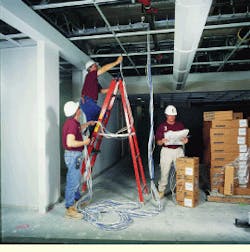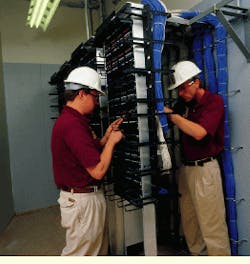Teamwork, cad, and documentation were as critical to the success of this network as the cabling.
Al Chapman
ADC Information Technologies Inc.
Chase Manhattan Mortgage, the third-largest mortgage lender in the country, needed a structured cabling infrastructure that would support all present and future software and communications applications at its new facility near Columbus, OH. The 1800 employees who would work in the new building use advanced financial, administrative, and customer-service software, including Lotus Notes, Microsoft Office, and work-flow programs, so they needed the support of a high-performance cabling system.
Chase Manhattan Mortgage had also installed multiple high-end, high-speed hardware and software systems to communicate with its other offices throughout the country. This facility was the first of three buildings that will eventually house 4000 employees.
Having worked with Chase Manhattan Mortgage, a nationwide subsidiary of Chase Manhattan Bank, on several cabling projects, adc Information Technologies Inc. (Columbus, OH) was named as the consultant to design and issue a request for proposals and was subsequently selected as the installation contractor for the project. Key in the selection of adc as a cabling partner was the latter`s understanding of Chase Manhattan Mortgage`s special needs and its commitment to completing the project on time and on budget. Chase Manhattan was on a fast-track construction schedule to complete the building and move in within four months of contractor selection.
Design team involved early
To meet the infrastructure demands of the project, the engineering design team took into consideration Chase Manhattan`s desire to "futureproof" the entire facility for future technologies and products. The involvement of the engineering team in the early phases of the project allowed adc to work closely with architects and other trade engineers to ensure that mission-critical information systems were given adequate consideration from the start.
adc`s design and installation team included two engineers, 23 cabling technicians, and two testing certification technicians trained and certified by amp Inc. (Harrisburg, PA) to install its Quantum fiber-optic structured-cabling system.
Chase Manhattan required that adc provide full documentation of the cabling network to facilitate a smooth, efficient move-in. The documentation included color-coded Autocad drawings of the 389,000-square-foot building, all workstations, and the equipment locations in the 2500-sq-ft computer room, or main communication (MC) room. The state-of-the-art computer room was designed to house high-speed mainframes, communications networks, a private branch exchange (pbx) switching system, cabling, and all other necessary equipment in a temperature-controlled, fire-safe, and secure environment.
The cabling-network documentation also included a drawing of the copper and fiber risers, Visio drawings for 30 7-foot equipment racks, assignment records for voice and data patch panels, Internet protocol (IP) addresses for all Ethernet users, and the telephone number of each user. In addition, the documentation included all cable and fiber certified test results.
The engineering team also provided a color-coordinated system at all workstations and telecommunications closets (TCs) to facilitate moves, adds, and changes. The company wanted to move its employees and their computer and telephone equipment quickly and easily throughout the facility with minimal disruption to its daily operations. Currently, Chase Manhattan is evaluating a software package to manage changes to the network. The company plans to incorporate the software package into its administrative procedures so that one process will update records for computer-aided design (cad) drawings, voice, voice mail, and data.
adc recommended that Chase Manhattan deploy a cabling system that would achieve higher bandwidth performance levels to meet the high-speed demands of Gigabit Ethernet, 1.2-gigabit-per-second Asynchronous Transfer Mode, and other high-bit-rate protocols. The cabling recommendation included a fiber backbone consisting of amp fiber-optic cable as well as horizontal cabling consisting of 324,000 feet of Quantum unshielded twisted-pair cable and 678,000 feet of Enhanced Category 5 cable, both from amp. Technically, the Chase cabling infrastructure would provide a minimum twofold bandwidth increase over currently available Category 5 cabling.
Subsystem design
Each workstation was equipped with a four-plex faceplate, two Enhanced Category 5 and two Quantum 8-pin modular jacks, and the necessary data patch cords. The horizontal subsystem includes one fiber-optic and two Enhanced Category 5 cables.
With a total of six TCs in its new building, it was crucial for Chase Manhattan to have a straightforward yet highly efficient TC subsystem design. The TC subsystem houses all the copper and fiber-optic cables and riser pairs, which are terminated in 48-port patch panels. All voice and data crossconnects are done with patch cables. All labeling in the TC exactly matches the labeling at the workstations and is indicated on the Autocad drawings, further facilitating an efficient move-in and any future changes. Ports in the 48-port patch panels are also color-coded to match the colors at the workstation. Additionally, all patch cables are specified to proper length with wire management to provide for clean and simple system administration. Multiple racks are designed and installed so that patch cables can connect any information port to any cable port. Cable trays were designed and implemented to route and support the thousands of cables, making system administration much simpler.
The cable labeling starts at the workstation number indicated on the jack and the cad drawings. This same number appears at the TC patch panel and remains the same through the copper riser cable to the MC room. For data applications, the numbers are the same at the workstation but different-colored icons are used. For example, at the workstation, three universal RJ-45 style jacks for voice are color-coded red, Gigabit Ethernet-speed local area network (lan) connections are blue, and additional lan requirements, such as 100Base-T and AS400, are green. These same colors also appear at the patch panels, and the patch cables match this color scheme as well.
adc provided all the labeling and Autocad documentation using Autocad v.14 and Microsoft Excel. Everything--from the riser cable to the patch cords--was labeled, color-coded, and then documented so that Chase Manhattan`s facilities managers could update them when necessary. The documentation also includes detailed information on furniture and department location, IP addresses for data communications, as well as how the telephone lines are fed.
The riser subsystem--from the TC back to the MC room--includes Category 3 multipair cables designed for voice and analog requirements, with a total of 8500 pairs in the riser. In addition, 24-strand fiber-optic cable was installed from the MC room to each TC.
The facility`s MC subsystem includes a fiber-optic cabling system located under a raised floor. This system connects all of the company`s mainframes, pbx, lan, wide area network, and peripheral equipment to the network. In addition to cable trays, an underfloor cable-management system was installed to allow for easier cable management. adc worked with the electrical engineers to ensure that power and connector requirements, power backup, and circuit requirements were accurately specified.
Installation challenges
To facilitate the various installation schedules and to meet the project`s completion deadline, adc developed a detailed project schedule to ensure optimum use of time. The various trade engineers conferred frequently with each other to plan the installation process and coordinate scheduling. With a six-phase timeline and specific dates for electrical inspections, it was crucial for the various trade engineers to work with each other within the time allotted.
With such a short installation window, cabling installation crews were scheduled in two shifts to meet deadlines and avoid scheduling conflicts with other trade engineers working at the site. The installers also had to act quickly on project change orders at the site. As many as 24 data-network engineers worked on the cabling implementation at one time. Additional coordination was required with the local telephone company, pbx, and data-equipment vendors.
Chase Manhattan Mortgage has been operational at its Columbus facility since last May. The facilities management team made full use of the Autocad drawings to prepare and plan for the actual moving of personnel, furniture, and equipment. The move took place over a six-week period. The design of the subsystems, use of next-generation cabling systems, and meticulous documentation and labeling facilitated the moves, adds, and changes throughout the expanding facility.
Two additional buildings are planned to complete the Chase Manhattan complex. As the company explores new software applications and communication tools, its underlying infrastructure will support new technologies while providing the higher-speed data rates required for mission-critical information systems.
ADC Information Technologies installers (from left) Cliff Manausa, Mark Perry, and Robin Bateman work on a small portion of the more than one million feet of amp Enhanced Category 5 and Quantum cable to complete the implementation for Chase Manhattan Mortgage.
Robin Bateman (left) and Kevin Ray of ADC Information Technologies complete the labeling and inspection of one of several telecommunications closets for the Chase Manhattan Mortgage project.
Al Chapman is president of ADC Information Technologies Inc. (Columbus, OH). He can be contacted at tel: (614) 240-5999, e-mail: [email protected].


